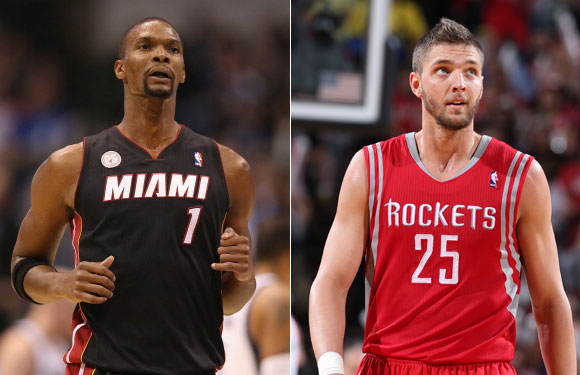
Was Friday disappointing to the Rockets? Yes. But franchise-altering, as some suggest?
It shouldn’t be.
Losing out on Chris Bosh at the 11th hour was an offseason gut punch that Houston fans know all too well. But unlike the infamous “basketball reasons” saga that nixed the Pau Gasol trade in 2011 followed by the failed Dwight Howard pursuit in 2012, it must be remembered that Daryl Morey and these Rockets are no longer playing from a weak hand.
In Howard and James Harden, the Rockets arguably have two of the NBA’s top 10 players. In the duo’s first year together, they won 54 games in a brutal Western Conference and showed significant improvement as the season went along. And after trading Jeremy Lin and Omer Asik, the team has financial flexibility to upgrade its bench and return as an even more talented group in 2014-15.
There’s one wild card in the mix, though, and it’s that pesky 3-year, $46-million offer sheet that Chandler Parsons signed with Dallas. The Rockets have until 10:59 p.m. on Sunday night to decide whether to match, and after missing out on their expected addition of Bosh, it’s unclear what Morey will decide to do in their “Plan B” scenario.
In short, it boils down to one root issue: Is the current Houston roster worth going all-in for? By matching Parsons and his roughly $15 million/year salary, it would all but eliminate the possibility of the Rockets having maximum cap room for foreseeable free-agency periods. It would, however, secure Howard, Harden and Parsons as the team’s core and allow the Rockets to fully commit to finding the best role players to optimize their success, starting immediately.
It’s not as sexy as the planned All-Star roster with Bosh. But after letting the initial sting wear off, it’s time to remember that the gap between these Rockets and true contention is not “max player” wide.
In these eyes, the Rockets are too close to turn back. Here’s why:
It’s easy to forget, but the Rockets were already poised to improve in 2014-15 simply from within. They went 54-28 (65.9%) in the first year of the Howard era, a mark that included a 21-13 (61.8%) transition period of November and December as the Rockets adjusted to having the league’s best center on both ends of the floor. Their 33-15 (68.8%) pace in 2014 would extrapolate to 56 or 57 wins over a full schedule – in other words, putting them right in the standings mix with Oklahoma City and the Los Angeles Clippers and closer to the 2/3-seed range than the 4/5/6-seed level.
Even the LeBron James-era Heat, likely the most talented free agency or trade-built team in the modern era, didn’t hit their full stride until Year 2 and Year 3. The Year 1 Heat (2010-11), even playing in the weak East, lost 24 games and weren’t a No. 1 seed. It took until 2012-13, the team that went 66-16 and reeled off 27 consecutive wins, for Miami to reach maximum efficiency.
So the idea that the current Rockets aren’t a contender because they went 54-28 in Year 1 and lost one playoff series isn’t something I’m willing to accept. Improvements in team chemistry and individual growth from young players including Harden (24), Parsons (25), Terrence Jones (22) and Pat Beverley (26) were already going to make the 2014-15 Rockets better than the 2013-14 group, regardless of any new additions. They did lose Lin and Asik from the bench, but…
Yes, losing Lin and Asik, if looked at in a vacuum, would weaken the rotation. But the roughly $17 million in cap room they have for the next 36 hours (or staying above the cap and using the trade exceptions and other exceptions beyond that), along with a probable lottery pick from New Orleans to use as trade bait, gives the Rockets ample opportunity to actually upgrade.
Think of it this way: if Lin and Asik were on the free-agent market now, and the Rockets had $17 million to spend to upgrade their current roster, would those be your first two calls? My guess is no. Asik, for all his strengths, was limited to being a 15-to-20-minute player most nights because of the presence of Howard. Lin was an average-at-best (and wildly inconsistent) three-point shooter and turnover prone, not ideal traits for a complementary backcourt mate to Harden.
Versatile forwards and guards with legitimate three-point range and defensive skills on the perimeter are better fits for the Houston rotation than Lin and Asik, and there are several such candidates available in free agency as well as the trade market that can fit into $17 million of space.
It all comes back to the Parsons decision, of course. Even with $17 million in space, it would be unreasonable to expect the Rockets to fully replace the contributions of Lin, Asik and Parsons. That team would take a step back, with an organizational focus of looking ahead to 2015 free agency.
In terms of title contention, the 2014-15 season would be over before it even started, and a year of Howard’s prime would be squandered. (Think Howard would remember that in 2016 free agency?)
To me, that scenario is unacceptable, unless the Rockets believe the only realistic route to winning a championship involves acquiring a third All-Star. While it would be nice, I don’t see it as necessary. Assuming Parsons is retained, the combination of organic growth from a young core of players and bench upgrades to Lin/Asik could easily bridge the gap between the mid-50s win total the Rockets had a season ago and the upper 50s-to-60 range of legit West contenders.
Bosh may have been the perfect fit, but he’s not the only fit. The Rockets are already playing with a strong hand, and folding for the outside shot of pocket aces down the road doesn’t seem practical.